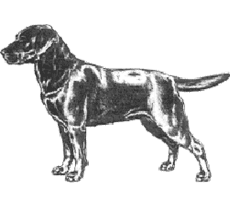Labrador Retriever
General Information - Labrador Retriever

Group:
gundog
Size:
large
Lifespan:
10-12 years
Exercise:
medium
Grooming:
low
Trainability:
very high
Watchdog ability:
high
Protection ability:
low
Area of Origin:
Canada
Date of Origin:
1800s
Other Names:
Yellow Retriever
Original Function:
Water retrieving
History
Once known as the St John's Dogs, the Labrador Retriever is one of the most popular breeds in the United States. Originally from Newfoundland, Canada the Labrador was trained to jump overboard into the icy waters to haul fisherman's nets to shore. These dogs had been known variously as the Black Water Dog, the Lesser Newfoundland, or the St John's Dog; they were descendants of dogs taken there by explorers, settlers and fishing crews. The dogs, found to have excellent hunting and fishing abilities, were brought to England early in the 1800s where their "modern" development carried on. Crossed with other local sporting breeds, the strong and sturdy Lab became, and continues to be, England's most popular gundog. This breed excels in obedience and field trials, needs plenty of outdoor exercise and especially enjoys swimming.
Temperament
The Labrador Retriever is a kindly, outgoing dog breed. The Lab's easy-going and friendly manner makes him an excellent addition to families with children. The Labrador Retriever is easy to train and, by nature, is a true sporting dog. Labs love swimming and will play fetch in the water for as long as you will!
Upkeep
Labradors are active and sociable dogs. They need daily exercise, preferably in the form of retrieving and swimming. Owners with swimming pools either must fence them out or be prepared to share the pool with dog. The Lab coat sheds water easily. It needs weekly brushing to remove dead hair. Although Labs can live outdoors in temperate climates, they are much happier indoors with their family.
Labrador Retriever
A breed standard is the guideline which describes the ideal characteristics, temperament, and appearance of a breed and ensures that the breed is fit for function with soundness essential. Breeders and judges should at all times be careful to avoid obvious conditions and exaggerations, as well as being mindful of features which could be detrimental in any way to the health, welfare or soundness of this breed.
Breed Standard - Labrador Retriever
 General Appearance:
General Appearance: Strongly built, short:coupled, very active; broad in skull; broad and deep through chest and ribs; broad and strong over loins and hindquarters.
Characteristics: Good-tempered, very agile. Excellent nose, soft mouth; keen love of water. Adaptable, devoted companion.
Temperament: Intelligent, keen and biddable, with a strong will to please. Kindly nature, with no trace of aggression or undue shyness.
Head and Skull: Skull broad with defined stop; clean-cut without fleshy cheeks. Jaws of medium length, powerful not snipy. Nose wide, nostrils well developed.
Eyes: Medium size, expressing intelligence and good temper; brown or hazel.
Ears: Not large or heavy, hanging close to head and set rather far back.
Mouth: Jaws and teeth strong with a perfect, regular and complete scissor bite, i.e. upper teeth closely overlapping lower teeth and set square to the jaws.
Neck: Clean, strong, powerful, set into well placed shoulders.
Forequarters: Shoulders long and sloping. Forelegs well boned and straight from elbow to ground when viewed from either front or side.
Body: Chest of good width and depth, with well sprung barrel ribs. Level topline. Loins wide, short:coupled and strong.
Hindquarters: Well developed, not sloping to tail; well turned stifle. Hocks well let down, cowhocks highly undesirable.
Feet: Round, compact; well arched toes and well developed pads.
Tail: Distinctive feature, very thick towards base, gradually tapering towards tip, medium length, free from feathering, but clothed thickly all round with short, thick, dense coat, thus giving ‘rounded’ appearance described as ‘Otter’ tail. May be carried gaily but should not curl over back.
Gait/movement: Free, covering adequate ground; straight and true in front and rear.
Coat: Distinctive feature, short dense without wave or feathering, giving fairly hard feel to the touch; weather:resistant undercoat.
Colour: Wholly black, yellow or liver/chocolate. Yellows range from light cream to red fox. Small white spot on chest permissible.
Size: Ideal Height at Withers - Dogs 56 - 57 cms (22 - 22½ ins); bitches: 55 - 56 cms (21½ - 22 ins).
Faults: Any departure from the foregoing points should be considered a fault and the seriousness with which the fault should be regarded should be in exact proportion to its degree and its effect upon the health and welfare of the dog.
Note: Male animals should have two apparently normal testicles fully descended into the scrotum.
DNZ No 324
Copyright Dogs New Zealand
28 Jun 2006
Any departure from the foregoing points should be considered a fault and the seriousness with which the fault should be regarded should be in exact proportion to its degree and its effect upon the health and welfare of the dog and on the dog’s ability to perform its traditional work.




